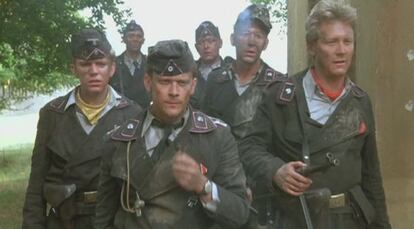The news of combatant units composed of former presidiaries on both sides of the Ukraine War – like the Alcatraz Ukraine Battalion – have taken me back to the old novels of Sven Hassel, starring soldiers of a criminal regiment of the German army in World War II, and I have read one that I still had pending of the 14 that he wrote, The bloody route (in the 1977 edition of Plaza & Janés). Following the disciplinary thread I have ended up unexpectedly immersed in another very different novel, the terrifying Divided (1971), by Alés Adamóvich, who has just published Edhasa in Spanish and on which the famous and terrible film was based Massacre (come and look), of Elem Klimov, held by the best refinement in the action of Nazis death squads. In Divided I have met the trail of the Diriwanger brigade of the SS, precisely a criminal unit of the Hitler army, the “black hunters” as the historian of Nazismo Christian I eat nazism baptized it since it was composed of convicted of convicts by poaching.
I thought that after so much time to read Sven Hassel I could be interested in him. I started in the late sixties with Punishment Battalion At school, where the black cassocks of the cures guards evoked the uniforms of the SS, the green of the blackboards to the NKVD and the noise of the brutal games in the patio the heat of the T-34. Then they came THE LEGION OF THE CONSENDED (The first series of the series), The Panzers de la Muerte, comrades of the front, General SS, Liquidad Paris!… In 1996 I interviewed him at his house (he lived in Barcelona with Turó Park, surrounded by military memorabilia) and, closing the circle, I wrote his obituary in 2012. At that time we already knew how many things Sven Hassel was invented (which remains to be published in Spanish an unfinished novel), starting with his feather name (It was actually called Borge Willy Redsted Pedersen), and that it was impossible that, as happened in GPU prisona criminal company will be allowed to triple the precious Tiger tanks, for example. But with Sven Hassel and his characters (Porta, Hermanito, Barcelona, the Legionnaire, the Elder, the Odious Heide, his own alter ego Sven), it happens the same as with so many remains of the past that they have been adhered to you: you never just got away from them, as of the old things piled up in the altillos.
In The bloody route We follow the characters of the Criminal Company in an amazing march by the Balkans between decomposed corpses, such with their burden of oscillating, heat, thirst and scorpions. They visit Athens, Thessaloniki, Belgrade, presence of mass executions, wildly combat melee in Russia. In a picaresco portesco episode and the Wolf mechanical chief are about to be shot by providing the army with an English tea that causes a disabling diarrhea and knows Marshal Model himself. The company (which in other novels has had pets like the cat Stalin and the black panther Ulrich) adopts here a great brown bear, Rasputincoming from a broken Russian circus and shares the penalties of the group and combat by its side, covered with steel helmet and even throwing hand grenades (!). Another episode, that of a captain stretched, cowardly, arrival and plug show The Iron Cross “The phrase” here the heroes are useless “could be perfectly from Sergeant Rolf Steiner (James Coburn). There are things that grind, such as that, in their eagerness to get more soldiers, the German army recruits even “a unit of German blacks.” Also that the Russians use “Kalashnikovs”, something unlikely because the AK-47 is, as its name indicates, of 1947, after the war.
I have read The bloody routehe said, with the excuse of the news of the criminal battalions, and I have done it in parallel to an illuminator essay on those German units in World War II, Criminal battalion, Hitler’s Penal Batallions (Fonthill, 2017), of the American military historian Walter S. Zapotoczny, which explains in detail its operation in the context of the German army and the penitentiary system of the III Reich. The criminal battalions, composed of convicted military (undisciplined, deserters and accused of insubordination or cowardice) and also for political and common prisoners, arose to rise the increasingly high losses of German soldiers in the course of the contest. The idea was to take advantage of that bag of inactive combatants that were prisons.
The Strafbattalions offered the possibility of leaving prison (or not entering it after committing a crime) and theoretically even redemption. Zapotoczny points out how some convicts took the opportunity and behaved heroically on the front, although he also recounts how others persisted in their criminal habits, committing atrocities for which the Nazi army did not stop providing a very appropriate framework. Actually, the criminal units, as can be assumed, were cannon meat and, stress Zapotoczny, were often used in suicidal missions (“travel missions to heaven”, they called them), to clean mines fields or recover corpses from the front. It is estimated that their casualties exceeded 50 %, there were very hard punishments and did not endow the best weapons (of course nothing of Tigers). They were often under the control of the Military Police (Feldgendarmerie, the nicknames Kettenhunde, “chained dogs”, by the metallic gargueras who looked). Up to three criminal battalions disappeared completely and the documentation describes them as “destroyed in battle.” Among the disciplinary troops were probation units such as those of convicted soldiers called with the number 500 (including the 500º Parachute Battalion of the SS), or those of civil prisoners with 999 (such as the 999th African light division). No 27 Panzer Criminal Regiment comes out (the invented disciplinary unit in which Sven Hassel’s characters fight). It is not bad to remember two of the occasions when criminal units have appeared in fiction (apart from the film version of The Panzers de la Muerte): In the series Children of the Third Reich And in the movie (and the novel) Eagle has arrivedin which Kurt Steiner and his men are sent to disciplinary troops.
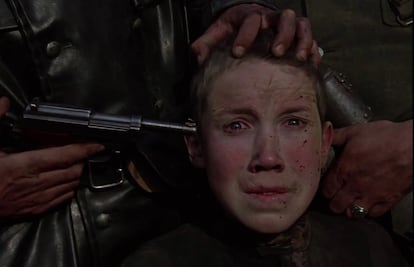
Zapotoczny dedicates ample space to speak of 36th Granaderos Division of the Waffen SS, which is the denomination upgraded At the end of the war of the sadly famous Brigade Dirlewanger, named for his commander, Oskar Dirlewangger, an alcoholic, murderer and rapist (convict before the war to violate a 14 -year -old girl and sexual assault) who became even too brutal for the standard (high, how he can imagine) of the SS. The sinister formation, composed of true murderers, participated in some of the most frightening acts of the Nazis in the East, burning living populations in Belarus and the reputation of the most criminal unit of the Hitler’s war machine, and looks that there was competition. The brigade was created in 1940 in the Waffen SS as an antipartisan group, initially with condemned by poaching – for its ability to track the enemy and their ability as shooters – and expanded recruiting criminals of the most vile until becoming a band of heartless and sadistic slaughterrs worthy of the worst scenario of the war of the thirty years. The way they devastated the busy Belarus when he unleashed them on her was creepy. “Where there is a fire, there is Dirwanger,” he said in the German army.
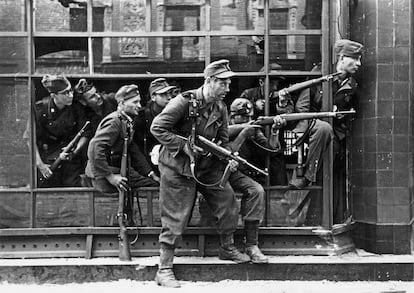
The Dirlewanger Brigade, to which Christian Ingrao dedicated her exciting and anthropologically illuminating unit study of the unit Black hunters (Perrin, 2009), unites the three books: Penal battalion, The bloody route y Divided. In Sven Hassel’s novel, in which numerous references appear to “the 500”, the classical disciplinary troops, to a captain of the SS is sent to disobey the orders and kill an important Russian prisoner to the Dirwanger brigade, where “you can shoot as much as you want, I assure you”, it threatens its superior, “but you will start at the lowest level.” Divideddestruction is described in 1943 by German genocidal troops from the Belarusian villages such as Jatyn herself (nothing to do, although sometimes it is written the same, with the massacre of Katyn, where the Russians murdered in 1940 the Polish official), Borki, Borívka or Zábalotie represented in the novel by Perejodi’s novel, where he is the young man of Perejodi, where he Flyora, involved partisan and witness of atrocities.
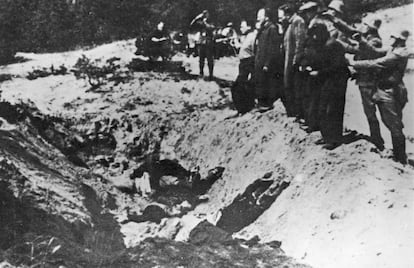
In the novel, a complex, disturbing and restless book, like the war itself, there are many things that appear in the film that was based on it (the script of Massacre Adamovich and Klimov wrote it together). There is the hallucinated horror of destruction of the town and the burning of its inhabitants locked in the barn, is the same German plane that sees everything-an extravagant Focke-Wulf FW-189 Ear (owl) recognition – are the ruthless mixed troops of foreign Germans and auxiliaries (described as “punishment battalions” in the novel). And there is the German commander who carries a monkey (data historically accredited by a surviving witness of the destruction of the village of Levischi), turned into the film into a rare tarsio, the small Asian ape similar to the lemurs.
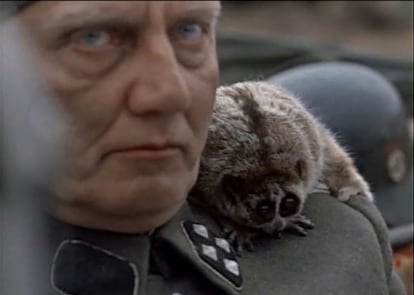
The Einsatzkommando of the SS that Jatin destroyed in reality was the 118 º Battalion of the Schutzmannschaft (a help squad), a Nazi police unit that included Ukrainian collaborationists, Russian volunteers recruited in the prisoners and forces of the Dirlewang Battalion. The novel is not explicitly mentioned to the battalion, but for the film Klimov wanted the character of the SS commander, who magnificently embodies the Latvian Viktors Lorencs actor, was based on Oskar Dirlewang. Actually, the Criminal leader Nazi did not die at the hands of the partisans after capturing him in an ambush (as in the novel and the film) but still had time for massacre Poles with his troops of savage lansquenetes brown in the survey of Warsaw in 1944. He was beaten until death by Polish guardians in the field of prisoners of Altshausen in June in June 1954.
The differences between the undisciplined, jaraneros comrades and in general Antinazis of Sven Hassel and the furtive beasts of Dirlewanger are great and notable. But it is still disturbing to be in both cases of criminal units and fight on the same side, with equal uniform and under the same flag.

